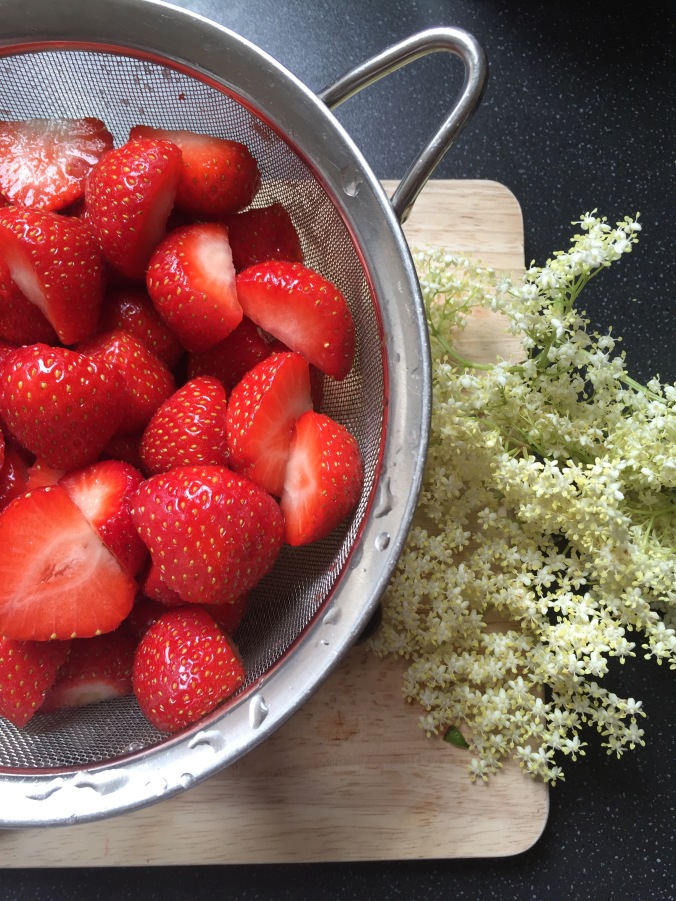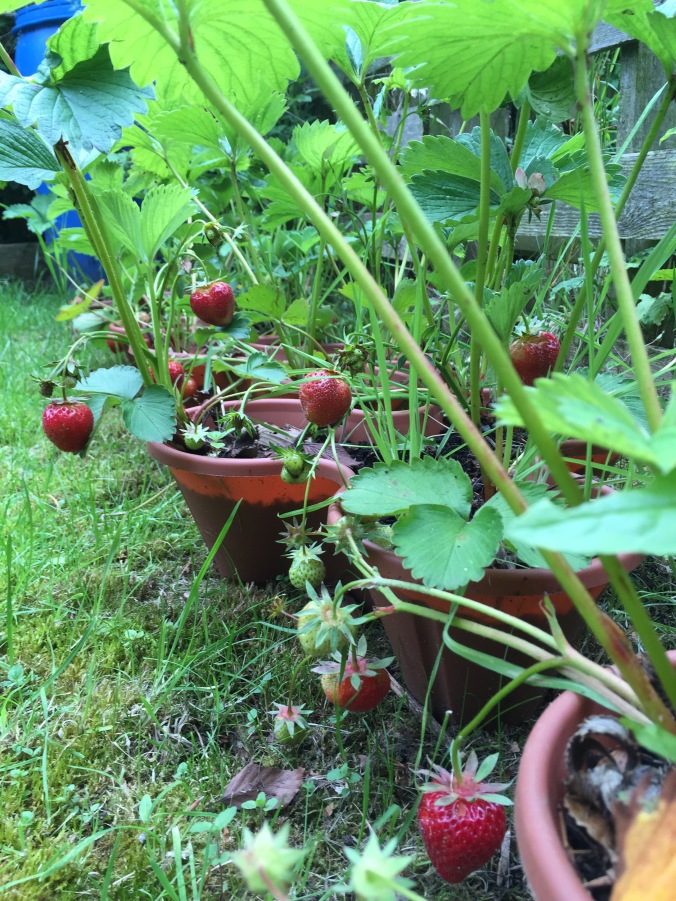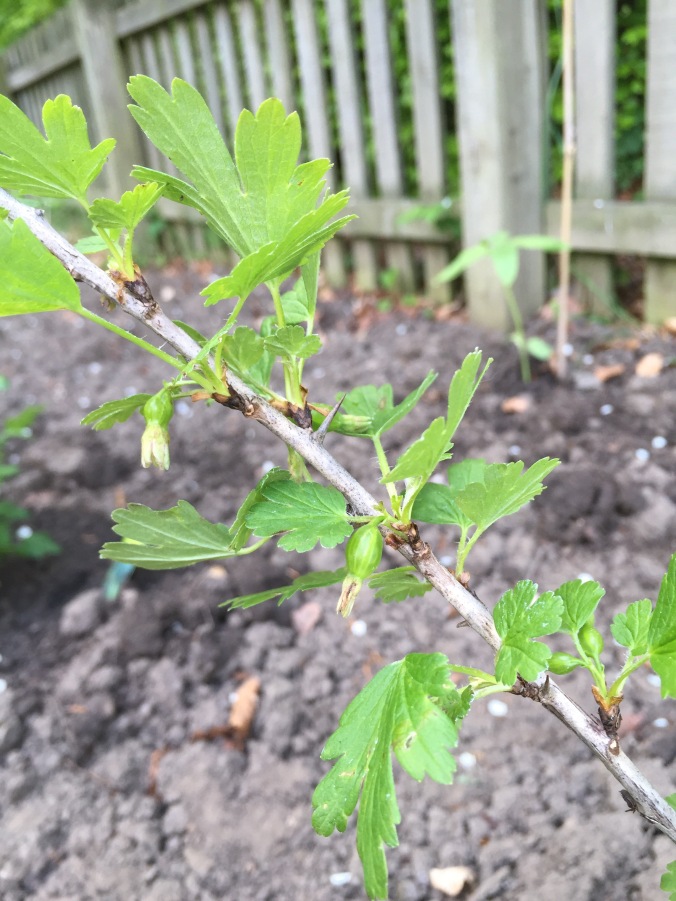
I’ve been a busy bee over the last couple of weeks, particularly in the kitchen. The best part of growing your own food has got to be eating it. Hands down, homegrown tastes the best each and every time, no matter what it is or what it looks like. I’ve been eagerly waiting for this specific time of year as the two things which sing “summer” to me are in season right now.
Elderflowers and Strawberries
Until last year, I’d never really tried anything with elderflowers in it but since then, well, it’s a different story! Last June I made strawberry and elderflower jam and I’ve got to say, the lift the elderflowers gave the jam was amazing. This year I was keen to make more jam and perhaps some cordial too to make the taste of summer last a little longer.
Armed with strawberries and elderflower heads (foraged from the trees which overhang the allotment fence) I got to work.
Elderflower Cordial

Makes enough for one medium sized Kilner bottle
10 elderflower heads
300g caster sugar
1 pint boiling water
25g citric acid
One large orange
One lime
1. Gently rinse the elderflower heads to remove any little creatures.
2. Put the sugar into a large mixing bowl and pour in the boiling water. Stir to dissolve the sugar and allow to cool slightly
3. Add the citric acid. Slice the fruit and add to the syrup. Finally pop in the elderflower heads.
4. Cover the bowl with either a lid or cling film and allow to infuse for 24 hours.
5. Strain the cordial through a sieve lined with a muslin square and transfer to a cooled sterilised bottle
Elderflower and Strawberry cordial

Makes enough to fill 2 medium sized Kilner bottles with a little left over for “quality control” testing!
10-15 elderflower heads
750g caster sugar
25g citric acid
225g strawberries (halved and hulled)
1 large unwaxed lemon
2 pints boiling water
1. Gently rinse the elderflower heads to remove any little creatures and place into a large heatproof bowl.
2. Add the sliced lemon, the citric acid and all of the sugar.
3. Pour over the boiling water and stir gently to help dissolve the sugar.
Allow the mixture to cool for 10-15 min.
4. Add the strawberries and stir the infusion. Cover the bowl with either a lid or cling film and allow the mixture to rest.
5. The mixture is going to infuse for about 72hours and will need to be stored in a cool darkish place. Give the strawberries a squish with a spoon to release their lovely flavour and stir the mixture twice a day.
6. When ready to bottle up, strain the syrup through a sieve lined with a muslin cloth and pour into cold sterilised bottles.
7. Quality test the leftovers poured over ice with some sparking water, a slice of lemon and a sprig of mint, summer in a glass
Strawberry and Elderflower Jam

Makes enough to fill 3 standard sized jam jars
900g strawberries (washed, halved and hulled)
1kg bag jam sugar with added pectin
8-10 elderflower heads
Juice of 1 lemon
1. Gently rinse elderflower heads
2. Layer the strawberries and sugar in a large mixing bowl. Just before you’re ready to add your final layer, pop in the elderflower heads, add the last layer of strawberries and sugar and cover with a lid or cling film.
3. Leave the fruit, flower and sugar mixture for 24 hours. The sugar will draw out the juice from the strawberries and by the time you’re ready to make the jam, there’ll be a lovely syrup suspending the strawberries.
4. Carefully remove the elderflower heads and prepare the make the jam.
Pop a small plate in the freezer (to check the jam has set later on) and put your scrupulously clean jam jars into a cold oven to sterilise while you’re making the jam. Turn the oven on and the temperature up to 120 degrees C
5. Put the fruity jam mixture into a large heavy based pan and add the lemon juice. It needs to be quite large as the jam mixture will rise and bubble like mad!
6. Over a low heat, stir the syrup until all the sugar has dissolved. Don’t rush this step, you need to make sure ALL the sugar has dissolved otherwise you risk the sugar catching the bottom of the pan and burning.
7. Once the sugar has completely disappeared, slowly increase the heat until the jam temperature comes up to 104 degrees C. If you don’t have a jam thermometer, don’t panic, you’ll know it’s pretty much there when it’s at a vigorous rolling boil.
8. Let the jam boil for 4-5 min then remove from the heat. Grab your small plate from the freezer and using a spoon, drop some of the jam onto the plate. After 30 seconds push the mixture gently with your finger and see if the jam has formed a skin. If it has, you’ll see the skin wrinkle up as you push the jam- the wrinkle test! If it’s still quite runny, pop the pan back onto the heat for another minute or two then test again.
9. Once you’re happy that the jam has reached its setting point and you’ve got wrinkly jam, you can remove the jam jars from the oven and carefully start to fill the hot jars with the hot jam.
10. Once filled, pop on a wax disc and close with the lid*.
Leave the jam to cool completely and store in the cupboard.
Now I’ve got that fresh taste of summer bottled and preserved so anytime I need a taste of sunshine, even on the coldest of days, it’s just a trip to the kitchen away.
* I usually boil the lids in a pan of water for about 20 min to sterilise.









 Bolstered by the happy sights at the allotment I thought I’d chance my luck and check on the potato progress. For the first year ever, I’ve got flowers on the potatoes. I never realised how pretty they are.
Bolstered by the happy sights at the allotment I thought I’d chance my luck and check on the potato progress. For the first year ever, I’ve got flowers on the potatoes. I never realised how pretty they are. 































































